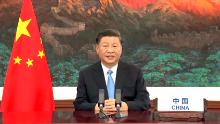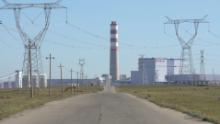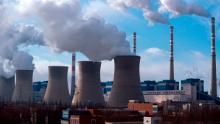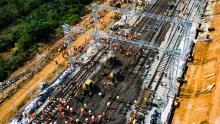
[ad_1]
The problem is that China’s vast economy just isn’t built for a dramatic pivot to green policy. It spent decades staking its ascent on massive infrastructure projects and manufacturing, building an economic engine that is now heavily reliant on dirty energy.
China remains the largest car market on the planet and the industry still leans heavily on gasoline and diesel-powered vehicles. Beijing has set lofty targets to promote the development and use of electric cars, but their market share remains scant.
“China’s announcement to strive for carbon free within the next four decades is an unprecedented move,” said Li Shuo, a climate and energy policy adviser for Greenpeace East Asia. “To achieve the vision would imply massive re-arrangement of the Chinese economy.”
An economy reliant on coal and oil
Coal is still China’s primary energy source by a long shot, accounting for 58% of the country’s energy demand, according to the National Bureau of Statistics. China burned about four billion tons of coal last year, making it the largest consumer in the world.
This year alone, eight provinces using the most energy in China, including Guangdong and Jiangsu, have directed 600 billion yuan ($90 billion) toward projects that use coal for chemical production, according to CREA, the environmental organization.
CREA also noted the eight provinces are planning to spend a combined 420 billion yuan ($62 billion) on oil refinery projects this year as China tries to reduce its reliance on foreign oil. Some 70% of the country’s crude oil supply is imported.
The spending on clean energy is small by comparison. All told, CREA said that the provinces are directing more than $300 billion toward projects that involve fossil fuels — about three times as much money as they are putting toward initiatives to promote electric vehicles and low-carbon energy projects.
The average amount that local governments are spending on clean energy “is so small that they are dwarfed by the spending plans for a few oil refineries alone,” Myllyvirta, the CREA analyst, wrote in a report released last month. He added that while China has said it would invest more in new infrastructure such as 5G and blockchain projects, that emphasis is “is not evident in the spending priorities we identified.”
Myllyvirta told CNN Business that phasing out fossil fuels will be China’s main challenge, adding that the industry is largely state-owned and “politically powerful.”
The largest car market
China has been the world’s largest car market for more than a decade. But cars are notorious for their contributions to environmental damage, and auto emissions are a major source of air pollution in Chinese cities, according to China’s Ministry of Ecology and Environment.
Beijing has been trying for years to boost the popularity of electric cars, which are considered key to meeting any target to reduce carbon emissions. Xi’s government wants new energy vehicles, such as electric or plug-in hybrid cars, to make up a quarter of its auto sales by 2025.
The government has imposed strict emission standards on vehicles that are sold in the country, and offered tax breaks and cash incentives to manufacturers and customers as a way to encourage them to make and purchase more electric cars.
But the government still “needs to go little faster” in expanding how much of the market electric cars can capture, according to Richard Black, director of the Energy and Climate Intelligence Unit (ECIU), a UK-based climate activism and advisory organization.
“It won’t happen by itself,” Black said. “The government will need to continue with the many measures it has to stimulate both supply and demand.”
Future climate goals
“This is another anti-China farce staged by the US for political purposes,” spokesman Wang Wenbin told reporters. “China’s achievements in tackling climate change are obvious to all.” He said the country’s carbon dioxide emissions as a unit of GDP have fallen nearly 50% since 2005, and that non-fossil fuel energy now makes up 15% of what the country uses — exceeding its targets for 2020.
But CAT warned that the activities fueling China’s economic recovery are still largely carbon intensive. And investment in the country’s dirtiest energy projects doesn’t appear to be fading anytime soon.
“Most worryingly, China remains committed to supporting the coal industry while the rest of the world experiences a decline,” CAT said, adding that the country “is now home to half of the world’s coal capacity.”
After lifting a ban on constructing new coal plants in 2018, the group said, China continued to ease restrictions on coal. CAT added that by the middle of 2020, the country had allowed more new coal plant capacity than in the last two years combined.
Xi’s carbon neutral announcement last week was light on detail, offering little clarity on just how aggressive — or not — China is planning to be if it hopes to reach its targets.
But Myllyvirta noted that even just the tone from the top could help, as long as there is follow-through.
“The significance of the [Xi] announcement is precisely in the potential for shifting the energy, emissions and investment trends that have been shifting in a concerning direction in the past few years,” Myllyvirta said, adding that a “major new policy target” introduced by Xi “can and should prompt reassessment of policies and investment priorities.”
— Helen Regan contributed to this report.
[ad_2]
Source link





